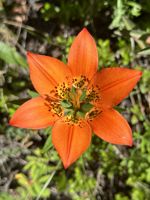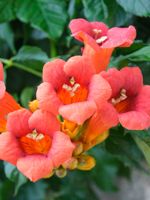Mon-Fri 9am - 5pm Mountain time
Trumpet Vine vs Wood Lily
Lilium philadelphicum
Campsis radicans
CUSTOM GROW
NOT AVAILABLE THIS SEASON - MIGHT RETURN
Wood Lily is a native perennial wildflower known for its vibrant, trumpet-shaped blooms in shades of orange to red. Its showy flowers appear mid-summer and are highly visible in meadows and prairies. The upward-facing flowers are an important nectar source for many pollinators, including native bees, butterflies, and hummingbirds.
Unlike most lilies, the Wood Lily’s flowers face upward rather than nodding. It is slow to establish and may take years before flowering, but once mature, it requires little maintenance. It is well-suited for pollinator gardens, naturalisation projects, prairie restoration, and open woodland plantings.
Wood Lily is the provincial flower of Saskatchewan and North America’s most widespread lily. Despite its wide natural range, populations have been declining. Habitat loss, overgrazing by deer, and unsustainable picking have reduced both its abundance and density across many regions. These pressures highlight the importance of protecting and restoring this once-common wildflower.
Trumpet Vine is a dense, multi-stemmed climbing vine with orange to red trumpet-shaped flowers. They bloom throughout the summer, adding a pop of colour to your landscape. Their fast growth rate and climbing abilities make it well suited for trellises, arbors, walls, and fences. It is recommended that structures are strong enough to bear the weight of the plant as it grows.
Regular pruning is recommended as blooms occur on new growth and it helps control the spreading nature of the plant. Care should be taken when planting the Trumpet Vine, especially in warmer climates as it can spread quickly. It is prone to suckering and will self-seed. Plant the right tree in the right place.
Wood Lily Quick Facts
Trumpet Vine Quick Facts
Toxicity: toxic to cats
Toxicity: slightly toxic if eaten, contact with leaves, flowers, and sap can cause minor skin irritation among people and animals

